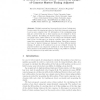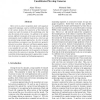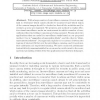ROBOCUP
2004
Springer
14 years 5 months ago
2004
Springer
Multiple cameras have been used to get a view of a large area. In some cases, the cameras are placed so that their views are overlapped to get a more complete view. 3D information ...
ICCV
2005
IEEE
14 years 6 months ago
2005
IEEE
Most work in action recognition deals with sequences acquired by stationary cameras with fixed viewpoints. Due to the camera motion, the trajectories of the body parts contain no...
ICCV
2005
IEEE
14 years 6 months ago
2005
IEEE
We present an approach for inferring the topology of a camera network by measuring statistical dependence between observations in different cameras. Two cameras are considered con...
AVSS
2005
IEEE
14 years 6 months ago
2005
IEEE
Until recently, traditional approaches to the task of camera calibration have relied on the use of accurate grid patterns, or strategically placed targets. Such approaches can pro...
AVSS
2005
IEEE
14 years 6 months ago
2005
IEEE
This paper reports on the integration of multi-camera tracking into an agent-based framework, which features autonomous task allocation for smart cameras targeting traffic survei...
ACCV
2006
Springer
14 years 6 months ago
2006
Springer
Although most works in computer vision use perspective or other central cameras, the interest in non-central camera models has increased lately, especially with respect to omnidire...
ACCV
2006
Springer
14 years 6 months ago
2006
Springer
With a large number of surveillance cameras, it is not an easy task to determine which camera should be monitored and which region of the camera images should be checked so that al...
ICMCS
2006
IEEE
14 years 6 months ago
2006
IEEE
In this article, we discuss 3D shape reconstruction of an object in a rigid motion with the volume intersection method. When the object moves rigidly, the cameras change their rel...
CRV
2006
IEEE
14 years 6 months ago
2006
IEEE
This paper presents the groundwork for a distributed network of collaborating, intelligent surveillance cameras, implemented with low-cost embedded microprocessor camera modules. ...
BROADNETS
2006
IEEE
14 years 6 months ago
2006
IEEE
— Camera sensors constitute an information rich sensing modality with many potential applications in sensor networks. Their effectiveness in a sensor network setting however grea...




